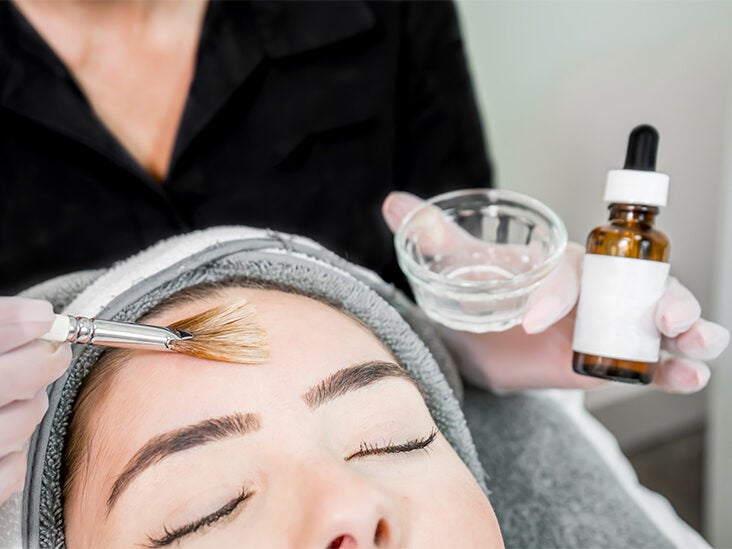 Posted On
Posted On
How Often Should You A Chemical Peel
 Posted On
Posted On
If you’re considering getting a chemical peel, then you should be aware of the risks and rewards. It’s a popular cosmetic treatment used to improve the appearance of wrinkles, sunspots, acne scars, and other facial skin issues. But how often should you do it for optimal results?
If done too frequently, Chemical peels can cause serious problems such as permanent skin discoloration or infection. If done too infrequently, you may not even see results from the procedure. So what’s the right amount of chemical peels that won’t harm your skin?
In this article, I’ll go through guidelines on when and how often to get chemical peels so you can decide what is best for your unique skin goals and condition.
Table of Contents
What Does This Treatment Do?
A chemical peel is a skin resurfacing treatment used to reduce the appearance of fine lines and wrinkles, sun damage, discoloration, age spots, and mild acne scars. A chemical solution is applied to the face which causes the outer layers of the skin to peel away gradually. As the old skin peels off, a new smoother layer with improved texture is revealed as well as an even complexion.
Chemical peels also help improve your skin’s texture and can even out any uneven tones or discolorations. Depending on the strength of your individual peel and how often you have them done, you may start to see fewer signs of aging more quickly than through natural means alone.
Peels generally use ingredients like alpha hydroxy acid, beta hydroxy acid, trichloroacetic acids (TCAs), and phenols to break down the bonds between cells in order to slough them off forcefully. There are different strengths of peels that vary in both their concentrations and ingredients which will determine how aggressive the treatment is for each individual’s needs.
Types Of Peels And How Often Should I Get One?
When it comes to chemical peels, there are a number of types that target different depths of your skin for different treatments. For example, lighter peels like glycolic or lactic ones can help with mild sun damage and discoloration issues like age spots, while deeper ones such as trichloroacetic acid (TCA) or phenol peels are best for treating wrinkles, sagging skin, and acne scars.
Light
Light Peels are generally the most gentle type of peel you can use and they’re usually used on the face only. These contain ingredients like alpha-hydroxy acids (AHAs) and beta-hydroxy acids (BHAs), which loosen the glue-like substance that holds the dead skin cells together. This reveals a new layer of cells underneath. It’s important to note that light peels should be done in a series rather than one single peel because they don’t penetrate very deeply into the skin.
The answer to this question depends on the severity of your skin issues and the type of light peel you receive. Generally, light peels can be done weekly or monthly in order to see a major difference in your complexion.
If you are having a light resurfacing peel such as glycolic acid or salicylic acid peel, then these can be done weekly or bi-weekly in order to reveal healthy glowy skin. Regular treatments will help to reduce any sun damage, hyperpigmentation, fine lines, and wrinkles.
Medium
Medium Peels use chemicals such as trichloroacetic acid (TCA), Jessner’s solution, or resorcinol – all at lower concentrations than deep peels – to penetrate through multiple layers of the epidermis for maximum rejuvenation. Medium peels typically require about five to seven days for full healing and may cause redness, dryness, and pigmentation changes during this period.
If you’re considering getting a medium chemical peel, it really depends on the desired result. Generally speaking, for those with skin irregularities such as acne scars, discoloration, and sun damage, medium peels can provide powerful results that require fewer treatments than lighter peels.
Most dermatologists recommend medium peels every 3 to 6 months to maintain your results. This allows you to gradually resurface your skin without going too deep into the dermal layers. If you opt for more frequent treatments, you could end up damaging your skin and reducing your overall results. Additionally, it’s best to wait at least 4 weeks between each treatment session so that your skin has time to heal and regenerate properly.
Deep
Deep peels are used for more aggressive chemical skin resurfacing. They use far more concentrated acids than the superficial or medium-depth chemical peels and stand a greater risk of complications. Therefore, deep peels should only be done by a qualified dermatologist or plastic surgeon with experience doing these types of treatments.

A deep peel should be done no more often than once every nine to twelve months. This is in order to allow your skin time to recover and heal between treatments. As with any type of chemical peel, you can expect redness, swelling, and some crusting of the skin afterward. It’s also important to follow all pre- and post-treatment instructions carefully when having a deep peel done or else you may increase your risk of an undesirable outcome.
Final Note
When it comes to chemical peels, there’s no one-size-fits-all answer. The frequency of your chemical peel treatments will depend on a number of factors including the type, strength, and efficacy of the formula being used.
Furthermore, using products with professional-grade ingredients applied at home (such as a post-chemical peel mask) can help extend the benefits of a treatment and prevent sensitivity between appointments. If you are considering receiving professional treatment with strong acids or going down the DIY route regularly, consider discussing with your dermatologist first to determine what’s safe and effective for your skin type.











